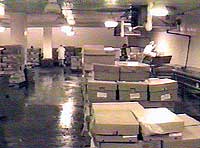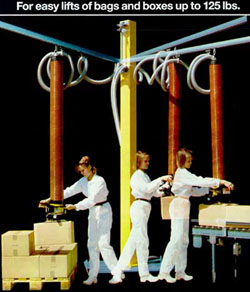Poultry Processing Industry eTool
Tasks » Warehousing
Once the chicken is packed in its shipping container, it is moved from the processing floor. Options are moving to a truck for immediate shipment or placement in a warehouse for storage. Lifting and moving heavy loads using awkward body postures is common practice. This operation includes the following tasks:
- Task 1: Fork Lift/Pallet Jack Operators: Moves loaded pallets around worksite and onto trucks.
- Task 2: Freezer/Cooler Worker: Manually loads/unloads boxes of frozen product on warehouse shelves.
Task 1: Fork Lift/Pallet Jack Operators
A picking room operator ensures that equipment (e.g., stunner, scalders, pickers, and conveyors) functions properly. Most of the time on the job is spent walking around the equipment, performing a quality assessment of its operation.
Hazards of this task may include:
Hazardous Situation
Workers in wet areas may contact electrical wires causing electrical shock.
Possible Solutions
- Train workers how to recognize electrical hazards.
- Report and correct electrical hazards as soon as they are discovered.
- Schedule preventative maintenance to inspect for frayed or damaged equipment.
- Use appropriate equipment for wet locations.
Hazardous Situation
Employees may need to work around moving and unguarded equipment where an accident may result in possible amputations or strangulation.
Possible Solutions
- Properly guard and regularly maintain machines and equipment.
- Use Lockout/Tagout program.
- Use appropriate equipment for wet locations.
Hazardous Situation
Workers in this area are exposed to high noise levels from the surrounding machinery and processing equipment, which can result in hearing loss.
Possible Solutions
- Provide workers with hearing protection devices and require their use.
- Use belt-driven plucking machines rather than chain-driven machines.
Task 2: Freezer/Cooler Worker

Employees manually load and unload boxes of frozen product on warehouse racking shelves. Occasional palletizing of loads may be necessary.
Hazards of this task may include:
Hazardous Situation
Stacking boxes over head height forces employees to bend the torso forward to place the box on the pallet, or to lift the box up to or above head height to place it on the top of the stack. Even when boxes are moved by conveyors directly to refrigerated trucks, employees remove the boxes from the conveyor and then stack then in the truck above head height or at floor level. This can result in back and shoulder injuries.
Possible Solutions
- Stay within NIOSH guidelines for safe lifting.
- Reduce the size of the box or decrease the amount of weight to be lifted.
- Provide lift assists, so boxes may be lifted from the conveyor with the assist and placed on the pallet.
- Provide palletizers or scissor lifts for employees so they do not need to bend over to place boxes on pallets lying on floors.
- Develop a whole new workstation to eliminate elevated and low lifts
- Use a telescoping conveyor to load trucks if loads are not palletized.
- Rotate employees to tasks that do not require heavy lifting.
Hazardous Situation
Employees working in cold environments must wear additional clothing, which can restrict movement and increase the force they must exert when performing lifting operations. Additionally, employees burn more energy in these environments to keep warm so fatigue may occur more rapidly, which increases the risk of injury. Cold areas may also have ice forming on work surfaces where slipping can cause injury or strain, especially if a load is being carried when the slip occurs.
Possible Solutions
- Provide warm clothing that fits properly and does not hinder movement.
- Provide adequate periods of rest so employees can recuperate.
- Rotate employees to less stressful conditions.
- Maintain areas and equipment to minimize slipping.




















